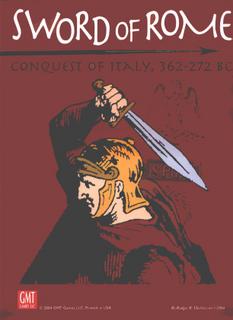More Shameless Self-Promotion

Everyone who enjoys playing board games, please raise your hand. Keep your hand up if you enjoy playing strategy board games (yes, like Risk, but moreso). How about wargames (no, not computer games)? Strategy-card driven wargames a.k.a. CDGs? (If you have no idea what that even means, just go ahead and put your hand down.) Ok, now that we're down to the approximately zero humans that make up this niche.....
A strategy card driven wargame, or CDG, is one where the action of the game is driven by one or more decks of special cards that are dealt to the players. Each card gives a player a number of different options, from moving their forces on the board, to solidifying their current position, to gaining reinforcements, to triggering certain historical events. These games are usually at the operational or strategic level, fairly highly abstracted, but the variety of the cards available can instill a lot of historical flavor and "chrome" with a minimum of extra rules. They also add a very nice "fog of war" element to the game, since players can't be certain what cards will be in play at any given time, even if they are very familiar with the contents of the deck. A designer named Mark Herman was responsible for the original application of this design, and it has become very popular in the hobby.
Sword of Rome is a CDG which I helped design and develop for GMT Games. It was published last summer, which is a fairly notable accomplishment unto itself, but that's a story for a future posting. This game is about the time when Rome was a relatively small city-state, struggling for supremacy on the Italian peninsula with the Gauls, the Greeks, the Etruscans, and the Samnites, along with several other smaller powers, plus Carthage's mercantile empire just over the horizon. Historically, Rome came out on top in a big way, of course, but it was really a very critical time in history which could have gone any number of different ways.
This summer, the various game design awards select their winners for the previous year, and I'm proud to say that Sword of Rome was recognized by several. We won the Origins Award for "Best Historical Board Game", the International Gamers Award for "Outstanding Historical Simulation", and the Charles S. Roberts Award for "Best Pre-WWII Board Game". I'm told that Sword of Rome is the first game to win all 3 of these awards, which is really amazing to me.
Most of the acclaim falls to my partner, Wray Ferrell, who conceived of and designed the game. He and I were both big fans of CDGs and Roman history, so I started out as his primary sounding-board and a playtester. When GMT's chosen developer had to quit the job, Wray asked me to take over, which I gladly did. We went through five full years of development from initial design to publication. Wray especially poured a huge amount of research and creative thought into the game, and he certainly deserves the praise the game is getting.





5 Comments:
Imperator! Imperator! Imperator!
How hard is it to play? Can an intelligent 11 yearold play?
Prop: As wargames go, Sword of Rome, are only moderately complex. It's based primarily on what I still think is the best CDG, "Hannibal: Rome vs. Carthage". We say if you know how to play Hannibal, you know how to play 90% of SoR. That probably doesn't help you if don't know anything about Hannibal, though. :) What games are you familiar with?
If I had to put all board games I know of on a scale of 1 to 10 strictly by rules complexity (ignoring strategic depth), with Candyland being a 1, Chess being a 3, and Advanced Squad Leader being a 10, then I guess I would call Sword of Rome a 5 or a 6 -- fairly easy to learn if you're familiar with wargames, pretty daunting if it's your very first exposure.
CDG - Tempus will mock me for this, but do the Hasbro produced Battle Cry and Memoir 44 count as CDGs? I wouldn't call them complicated (maybe 2 stars on the Tempus complexity scale), but cards play a huge role. Also, it's really fun to play with the little plastic tanks and cannons :-)
I thought about that myself and I would have to say that Battle Cry and Memoir '44 (as well as the upcoming Command and Colors: Ancients that GMT is doing) should be categorized as CDGs. But the "main line" of CDGs are, I would say:
* We the People (Avalon Hill)
* Hannibal: Rome vs. Carthage (AH)
* Successors (AH)
* For the People (AH, GMT)
* Paths of Glory (GMT)
* Thirty Years War (GMT)
* Wilderness War (GMT)
* The Napoleonic Wars (GMT)
* Berlin to Barbarossa (GMT)
* Sword of Rome (GMT)
* Empire of the Sun (GMT) - although I personally think this one stretches the envelope pretty far
* Assyrian War (Udo Grebe)
* Triumph of Chaos (Clash of Arms) - another one that is just inside my definition of a CDG
* Wellington (GMT)
Plus future additions I know of:
* Twilight Struggle (GMT)
* Here I Stand (GMT)
* Unhappy King Charles (GMT)
* Shifting Sands (Multi-Man Publishing)
And BTW, I think I would say that Battle Cry and Memoir '44 probably rate a 4 on my scale -- Certainly more rules than Chess, right? (I could explain the basic rules sufficient for playing Chess on an index card, I think.)
Post a Comment
<< Home